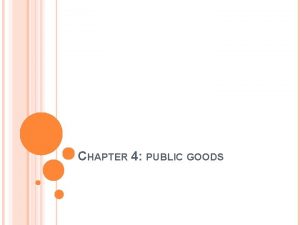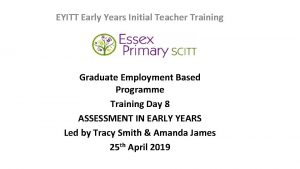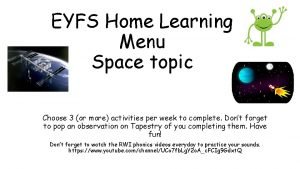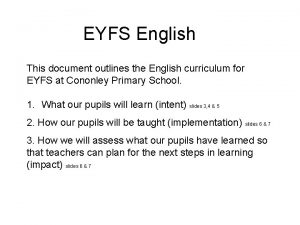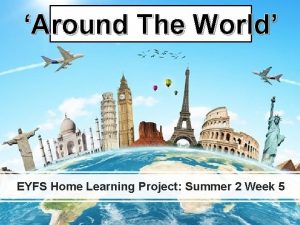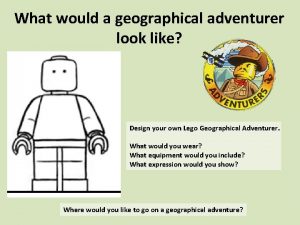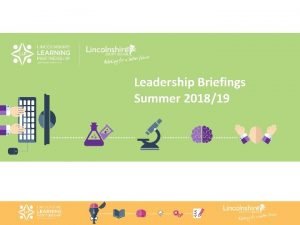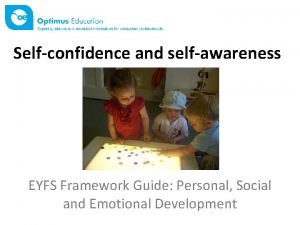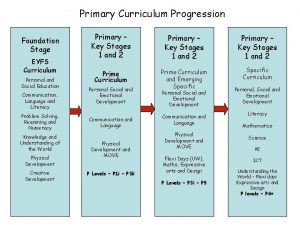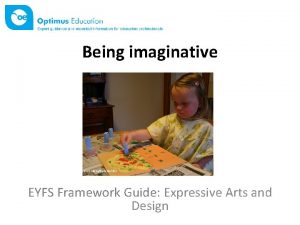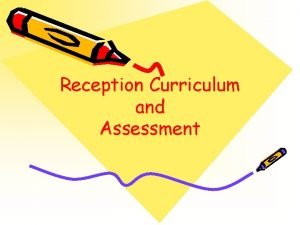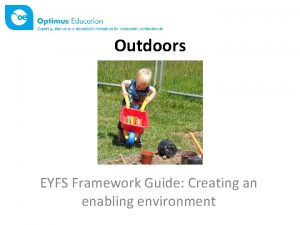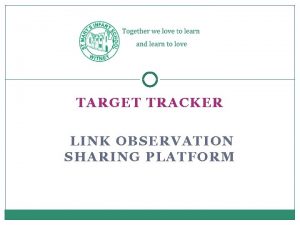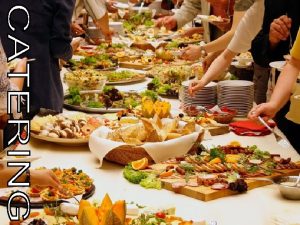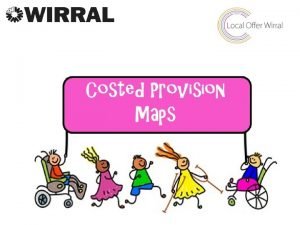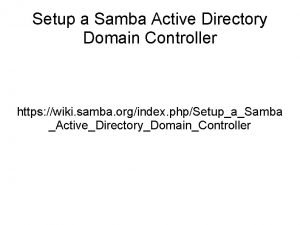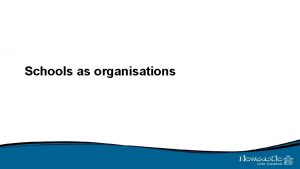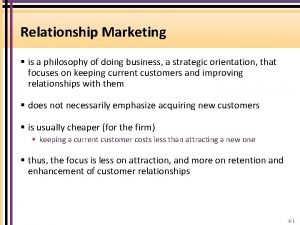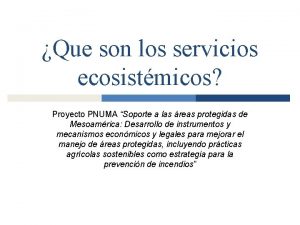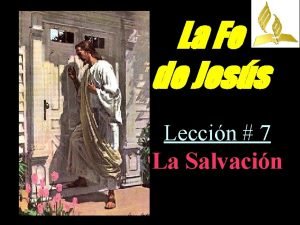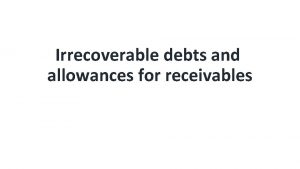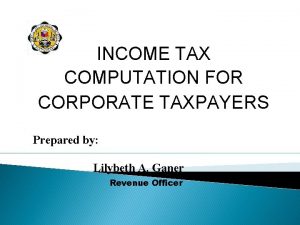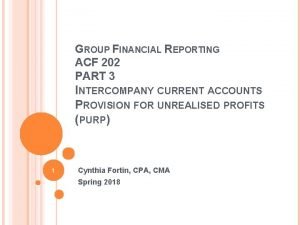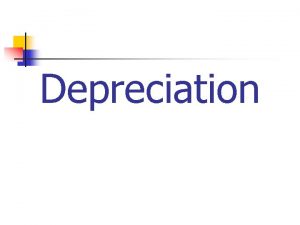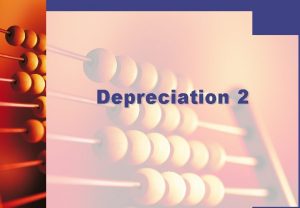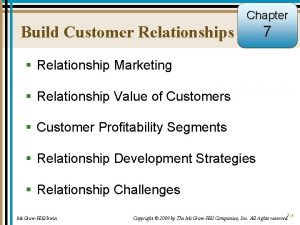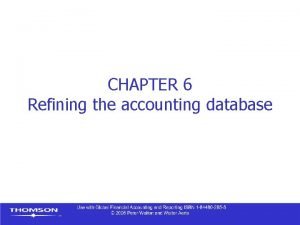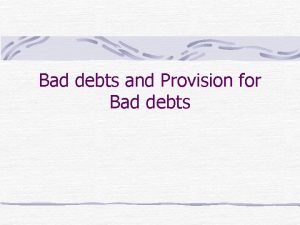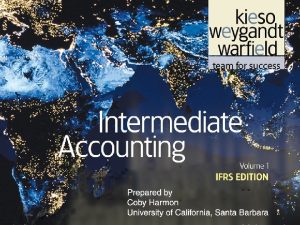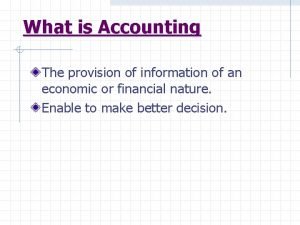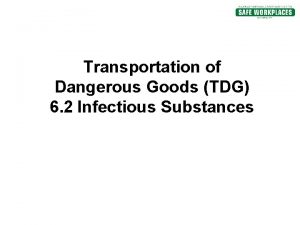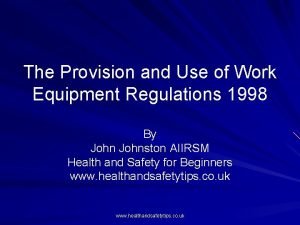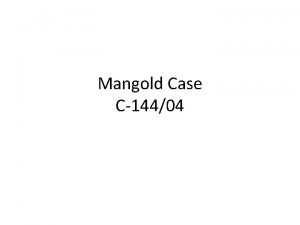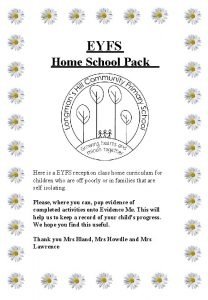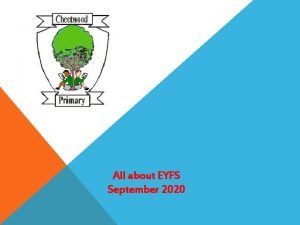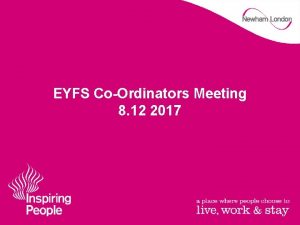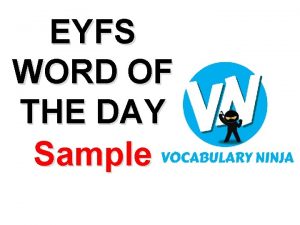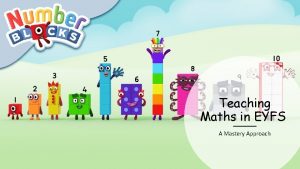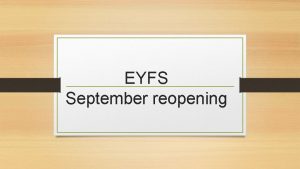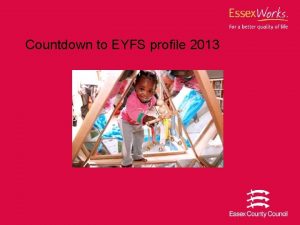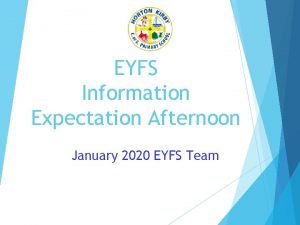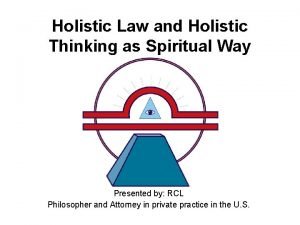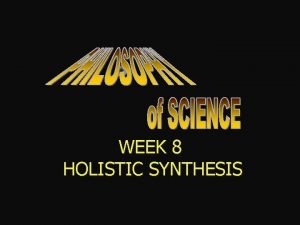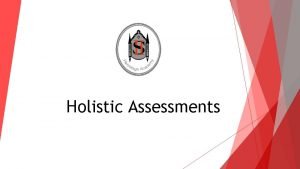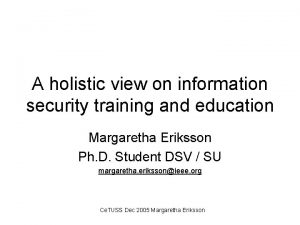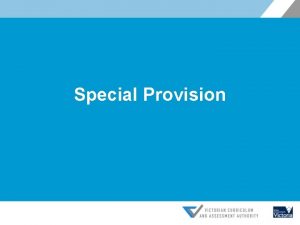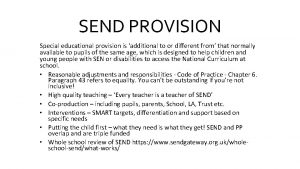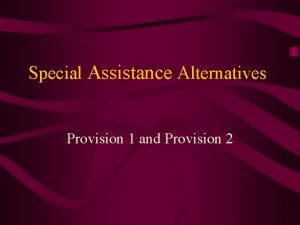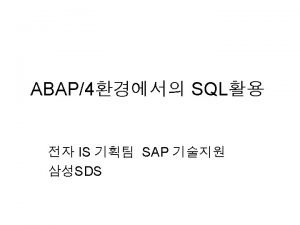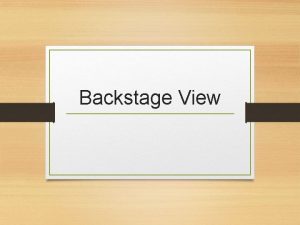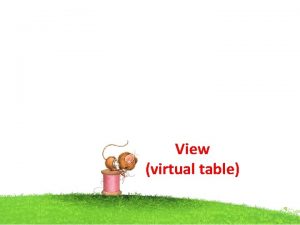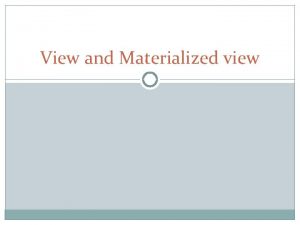EYFS Training A holistic view of EYFS provision







































- Slides: 39

EYFS Training A holistic view of EYFS provision including learning environments (both indoor and outdoor), curriculum, activities and independent learning Jo. Anne Schultz

Aims of the training Summarise the Development Matters document and EYFS Framework. Characteristics of Effective Learning Develop confidence with observations. Enabling independent learning. Some ideas for enhancing indoor provision. Extending early years provision outdoors.

Development Matters Children are born ready, able and eager to learn. They actively reach out to interact with other people, and in the world around them. Development is not an automatic process, however. It depends on each unique child having opportunities to interact in positive relationships. Enabling environments.

Themes of the EYFS guidance The four themes of the EYFS underpin all the guidance. The Development Matters document shows how these themes, and the principles that inform them, work together for children in the EYFS.

Principles Every child is a unique child who is constantly learning and can be resilient, capable, confident and self-assured. Practice Practitioners • understand observe each child’s development and learning, assess Progress and plan for next steps. • support children to develop a positive sense of their own identity and culture. • identify any need for additional support. • keep children safe. • value and respect all children and families equally.

Principles Children learn to be strong and independent through positive relationships. Practice Positive relationships are • warm and loving, and foster a sense of belonging. • sensitive and responsive to the child’s needs, feelings and interests. • supportive of the child’s own efforts and independence. • consistent in setting clear boundaries. • stimulating. • built on key person relationships in early years settings.

Principles Children learn and develop well in enabling environments, in which their experiences respond to their individual needs and there is a strong partnership between practitioners and parents and carers. Practice Enabling Environments • value all people • value learning They offer • stimulating resources, relevant to all the children’s cultures and communities. • rich learning opportunities through play and playful teaching. • support for children to take risks and explore.

Development Matters The guidance consists of 7 areas of learning- PSED, PD, CL, Literacy, Mathematics, UW, EAD. Each of the 7 areas of learning is then separated into two or three different aspects- totalling 17 aspects: e. g. Mathematics is divided into two areas. Numbers & Shape, Space and Measure. Each aspect has its own ELG descriptor to which we judge the children’s attainment. The guidance is divided into ages and stages of development: birth to 11 months, 8 -20 months, 16 -26 months, 22 -36 months, 30 -50 months and 40 -60 months +. The age bands overlap because they are not to be seen as fixed age boundaries, but rather suggest a typical range of development.

Three Prime Areas The Prime areas develop quickly in response to relationships and experiences, and support learning in all other areas.

Specific Areas Include essential skills and knowledge for children to participate fully in society.

Characteristics of Effective Learning The Unique Child reaches out to relate to people and things through the Characteristics of Effective Learning, which move through all areas of learning. They describe factors that play a central role in a child’s learning and in becoming an effective learner. They are vital elements of support for the transition process from EYFS to year 1. They run through and underpin all 7 areas of learning and development.

All interlinked…


Statutory EYFS Framework The EYFS statutory framework sets the standards that all early years providers must meet to ensure that children learn and develop well and are kept healthy and safe. It promotes teaching and learning to ensure children’s ‘school readiness’ and gives children the broad range of knowledge and skills that provide the right foundation for good future progress through school and life.

Observations Practitioners’ assessments are primarily based on observing a child’s daily activities and events. In particular, practitioners should note the learning that a child demonstrates spontaneously, independently and consistently in a range of contexts. Observational assessment is central to understanding what children really know and can do. Practitioners watch, listen and interact as children engage in everyday activities, events and experiences, and demonstrate their specific knowledge, skills and understanding. Some observations will be planned but some may be a spontaneous capture of an important moment. It is likely that observations of everyday activities will provide evidence of attainment in more than one area of learning.

Adult-led vs Child-initiated learning Adult-led activities can offer insight into children’s attainment by making sure the child has the opportunity to demonstrate what they know, understand can do. Most evidence for EYFS profile judgements will come from practitioners observing a child’s self-initiated activities.

Child-initiated activity Children with effective learning characteristics: are willing to have a go are involved and concentrating have their own ideas choose ways to do things find new ways of doing things enjoy achieving what they set out to do To accurately assess these characteristics, practitioners need to observe learning that children have initiated rather than only focusing on what children do when prompted. Children need rich opportunities to initiate ideas and activities so that they can develop the learning characteristics that are assessed by the EYFS profile. These characteristics also support lifelong learning.

Good Examples of child-initiated observations https: //www. youtube. com/watch? v=yt 69 at. Pdg 3 I

Parental links Accurate assessment requires a two-way flow of information between settings and home. A review of a child’s achievements should include those demonstrated at home. Assessments that do not include the parents’ contribution give an incomplete picture of a child’s learning and development.

Reporting During the final year of the EYFS, practitioners must carry out ongoing (formative) assessment to support each child’s learning and development. There is no requirement for how this is recorded or specifically when assessments take place. Practitioners should be mindful of their professional responsibility for the learning and development of children in their care and plan the provision needed to enable children to take the next steps in their learning. When compiling the profile, practitioners must review the evidence gathered in order to make a judgement for each child and for each ELG. The judgement must say whether the child’s learning and development is: • best described by the level of development expected at the end of the EYFS (‘expected’) • not yet at the level of development expected at the end of the EYFS (‘emerging’) • beyond the level of development expected at the end of the EYFS (‘exceeding’) Practitioners may refer to the exemplification materials.

Exemplification materials https: //www. gov. uk/government/publications/eyfs-profileexemplication-materials

Assessment and Reporting Arrangements (ARA)

GLD- Good Level of Development Ensures readiness for Learning in KS 1 and beyond. Children must be achieving at least ‘Expected’ in all 3 Prime areas, plus Mathematics and Literacy. Practitioners must consider the whole of each ELG when making their decision. They must avoid splitting the descriptor into sections and ‘ticking them off’. The most accurate picture of the child’s overall embedded learning will come from a holistic view of the descriptor.


What do we need to report on? The EYFS profile summarises and describes children’s attainment at the end of the EYFS. Every child’s attainment in relation to the 17 early learning goal (ELG) descriptors. A short narrative describing the child’s 3 characteristics of effective learning.

Enhancing provision

Enhancing provision

Memories If you think back to your childhood, what were your best memories?

Outdoor play opportunities https: //www. youtube. com/watch? v=S_mwqo 7 UMEA

Outdoor Learning Just as a teacher has the ability to take an idea and adapt it to the needs of their specific children, they also have the power to tweak an ‘indoor’ activity to make it also suitable outdoors. Most children’s memories are grounded in the outdoors, let’s foster that notion and turn it to our advantage. Outdoor experiences foster enjoyment, freedom, creativity and inspiration. Juliet Robertson, Dirty Teaching, says ‘humans [need] nature not just to survive, but to thrive’.

Benefits If you think about the Prime areas- CL, PD and PSED. How much of these would be covered outdoors? What about the Characteristics of Effective Learning? How would they tie in with an outdoor curriculum? Children’s health and well-being can be positively impacted by the use of outdoor spaces- we all know what it feels like after a period of wet playtimes (cabin fever!).

Ask children to make a line with lego… Ask children to make a line with stones…

Using natural resources If children use natural materials such as shells, stones, then a variety of results would transpire- none of which would be wrong. Using natural resources gives rise to discussions between children and generates further challenge-based explorations. Build a tower… Compare a toy car to a stick…

Setting up outdoors Scandinavian proverb …‘There’s no such thing as bad weather, only bad clothing’. Ensure children and adults have suitable clothing and footwear. Have ready a basic set of resources- pencils, make mini notebooks from quartered A 4 paper, portable seats, clipboards, light coloured cloth, chalk, magnifying glasses, viewer (homemade cardboard frame), natural materials, identification guides. If its not suitable to use the outdoors every day in your setting, then try to aim for at least once a week- Have ‘Welly Wednesdays!’ or ‘Fun Fridays!’.

Benefits of being outdoors Fresh air Physical activity A feeling of space and freedom Learning how to cope in all weathers and seasons Natural light Access to nature A change from being in the classroom Unexpected interactions (e. g. a plane flying overhead, or a squirrel climbing a tree) which provide additional learning opportunities A greater range of multisensory experiences

Ways to extend learning outside Ask the children to find something interesting. Use natural resources for counting and measuring and listen to the lines of enquiry- e. g. do we include the stem? Compare objects- not only lends itself to mathematical thinking, but also communication and language. If they can compare and contrast two objects outdoors, then imagine how this would lend itself to comparing story settings. Make a landscape using found materials- stones could be mountains, weeds a meadow, a piece of blue rope a river. Imagine the positional language that children would use in role play! Listen to the discussions involved if you began to make an ‘art attack’ style collage with materials found outdoors. Using adjectives to describe objects outdoors- i. e. green grass, tickly feather, long stick. Create a map of sounds which can be heard in front, behind, to the left and to the right. Cloud watching- just think of the creativity! Build a den.

Nim- an ancient game of mathematical strategy Make a collection of 20 objects to use as counters. Each player takes turns to take either 1, 2 or 3 objects. The player who takes the last object loses the game. Encourage children to look for patterns and find the secret strategy for winning. It will probably really surprise you who are the most able children when playing this game- much like the learning of Chess.

Useful Resources https: //creativestarlearning. co. uk/ Juliet Robertson says ‘For me, teaching is more than making a difference…Through teaching children we touch the future. By teaching outside, we make it real’.

Any questions? Please fill in a questionnaire, it helps us to tailor training for the future. Thanks for coming! Jo. Anne Schultz
 Public provision
Public provision Eyfs principles
Eyfs principles Eyfs space activities
Eyfs space activities Eyfs english curriculum
Eyfs english curriculum The world eyfs
The world eyfs Eyfs geography
Eyfs geography Eyfs profile data 2018
Eyfs profile data 2018 Eyfs
Eyfs Eyfs curriculum progression
Eyfs curriculum progression Mark making reception
Mark making reception Hampshire services for young children
Hampshire services for young children Being imaginative eyfs
Being imaginative eyfs What is eyfs
What is eyfs Enabling environments eyfs
Enabling environments eyfs Target tracker link
Target tracker link Examples of institutional catering
Examples of institutional catering Costed provision map example
Costed provision map example Samba active directory domain controller
Samba active directory domain controller Summarise types of early years provision
Summarise types of early years provision Core service provision
Core service provision Servicios ecosistémicos de soporte
Servicios ecosistémicos de soporte Unrealized profit in manufacturing account
Unrealized profit in manufacturing account Qué acto aseguro nuestra salvación
Qué acto aseguro nuestra salvación Provision for receivables
Provision for receivables Nolco and mcit illustration
Nolco and mcit illustration Hire purchase in balance sheet
Hire purchase in balance sheet Purp accounting
Purp accounting Provision food list
Provision food list Provision for depreciation
Provision for depreciation Provision for depreciation
Provision for depreciation Customer goals of relationship marketing
Customer goals of relationship marketing Provision vs accrual
Provision vs accrual Journal entry for provision for doubtful debts
Journal entry for provision for doubtful debts What is bills receivable with example
What is bills receivable with example As 29 accounting standard
As 29 accounting standard Is notes payable a current liability
Is notes payable a current liability Returns outwards
Returns outwards Un1845 packing instruction
Un1845 packing instruction The provision and use of work equipment regulations 1998
The provision and use of work equipment regulations 1998 Mangold case summary
Mangold case summary
